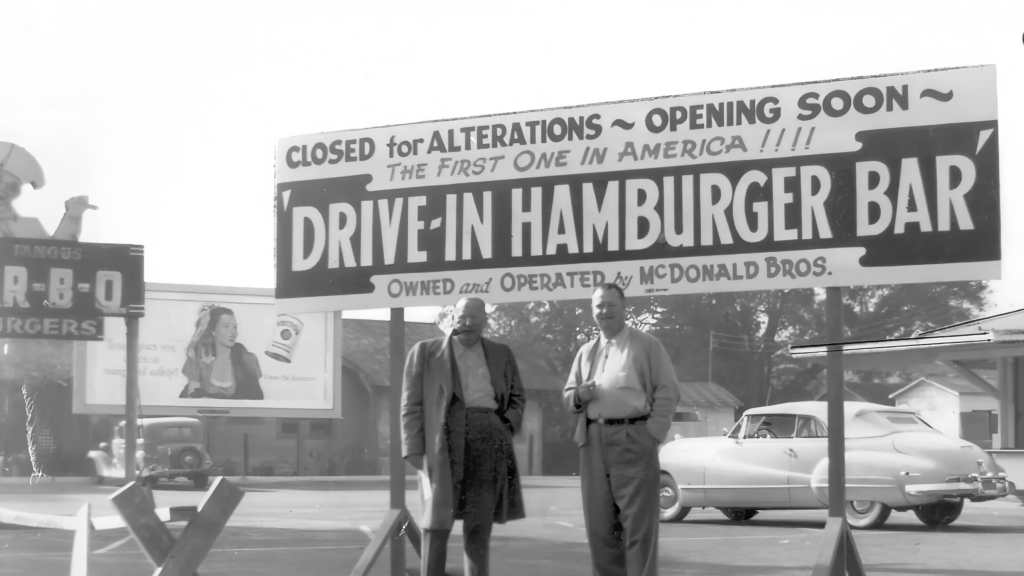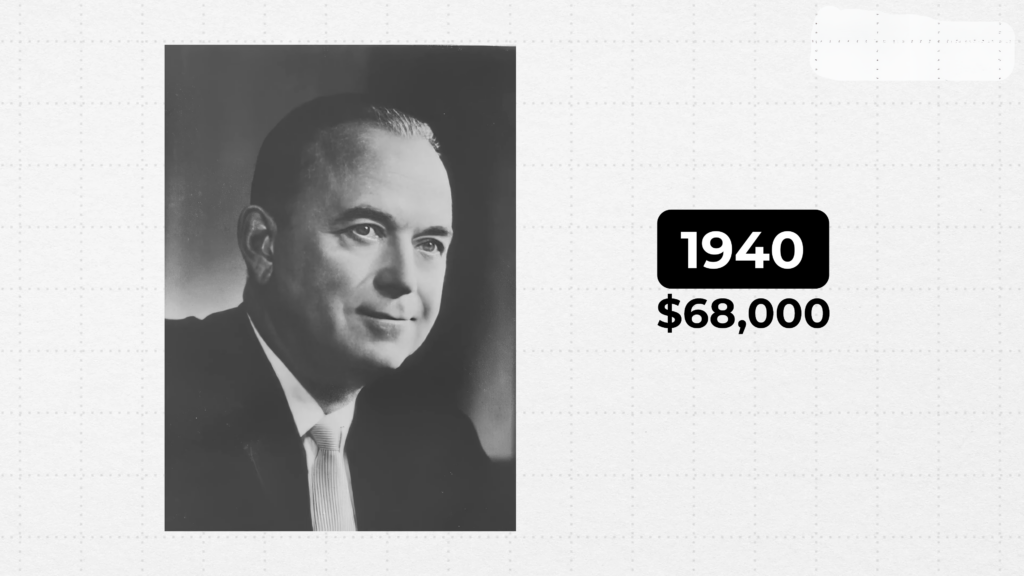When you think of iconic global brands, McDonald’s is likely one of the first that comes to mind. Its golden arches are instantly recognizable, and the brand has become synonymous with fast food around the world. But McDonald’s is much more than just a restaurant chain; it’s a cultural and economic juggernaut that has revolutionized the way we think about quick-service dining.
Today, with over 40,000 locations in more than 100 countries, McDonald’s serves a staggering 69 million customers every single day. This journey from a small hot dog stand to the world’s largest fast-food empire is nothing short of extraordinary. Let’s take a deeper look into the history of McDonald’s, exploring the key moments and decisions that propelled it to global success.
The Early Days of McDonald’s
The story of McDonald’s begins in 1937, in the midst of the Great Depression. Brothers Maurice “Mac” McDonald and Richard “Dick” McDonald, originally from a poor Irish immigrant family in New Hampshire, were determined to create a better life for themselves. They saw an opportunity in the burgeoning food industry and decided to take a leap of faith by opening a small food stand called the Air Dome in Monrovia, California. The stand initially focused on selling hot dogs—a popular and affordable food at the time. Their business was modestly successful, but the brothers were keen to explore further opportunities.

The Move to San Bernardino
By 1940, the McDonald brothers had saved enough money to relocate their operation to San Bernardino, California, where they believed they could reach a larger customer base. With a $5,000 loan from the Bank of America, they set up a new establishment named McDonald’s Barbecue. This new venture featured a more extensive menu, offering 25 items, with an emphasis on barbecue, which was all the rage at the time. The location thrived, thanks to its prime positioning and drive-in service, attracting a steady stream of customers. However, even with their growing success, the McDonald brothers were not content; they were constantly seeking ways to improve and streamline their business.
Innovation and Streamlining: The McDonald’s Model
As the United States emerged from World War II, the economy began to shift, and the demand for quick, affordable food increased. The McDonald brothers observed that their hamburgers were the most popular item on their menu and realized that they could capitalize on this by simplifying their operation. They envisioned a restaurant where food could be prepared and served with unprecedented speed and efficiency, without compromising on quality. Inspired by the assembly line techniques pioneered by Henry Ford, they decided to close their restaurant temporarily in 1948 to redesign their business model from the ground up.
The Birth of the Speedee Service System
When McDonald’s reopened later that year, it featured a drastically simplified menu, offering just six items: hamburgers, cheeseburgers, potato chips, coffee, soft drinks, and apple pie. This new approach allowed them to focus on perfecting a few items rather than diluting their efforts across a broad menu. They introduced the Speedee Service System, which was a revolutionary concept in the restaurant industry. This system emphasized quick service, consistent food quality, and customer convenience. By reducing the complexity of their operation, the McDonald brothers were able to serve customers faster and more efficiently than ever before. The restaurant quickly became a local favorite, particularly among workers and families who appreciated the value and speed of service.

The Golden Arches: Branding and Expansion
By the early 1950s, the McDonald brothers recognized the need to modernize their restaurant’s appearance to attract even more customers. They wanted a design that would make their restaurant stand out from the competition and be easily recognizable from a distance. To achieve this, they collaborated with architect Stanley Clark Meston to create a new building design that would become iconic. The result was a restaurant adorned with bright red and white tiles, shiny stainless steel, and large glass windows that invited passersby to peek inside. But the most striking feature was the pair of 25-foot yellow arches on either side of the building, which later became known as the Golden Arches. These arches not only made the restaurant visually appealing but also became a symbol of the brand, representing the promise of fast, affordable, and consistent food.
Franchising the McDonald’s Concept
The success of the revamped McDonald’s restaurant in San Bernardino did not go unnoticed. The McDonald brothers realized that they had developed a winning formula that could be replicated in other locations. They decided to begin franchising their concept, allowing others to open McDonald’s restaurants under their brand and operating system. The first franchise with the Golden Arches was opened in Phoenix, Arizona, in 1953, and it marked the beginning of McDonald’s rapid expansion. The franchising model allowed the McDonald brothers to grow their business exponentially, as each new franchisee brought additional revenue while adhering to the strict standards that had made the original McDonald’s a success.

The Man Who Built McDonald’s
In 1954, a man named Ray Kroc entered the picture, and his involvement would change the course of McDonald’s history forever. Kroc, a traveling salesman who sold Multimixers—machines that could mix multiple milkshakes at once—was intrigued when he noticed that the McDonald brothers were ordering an unusually large number of these machines for their single restaurant. Curious to see what made this small operation so successful, Kroc decided to visit the McDonald’s restaurant in San Bernardino. What he found amazed him: a clean, efficient, and family-friendly operation that was unlike any other drive-in restaurant he had seen before. The food was delicious, the service was fast, and the customers were clearly satisfied. Kroc immediately saw the potential for expanding this concept across the United States.
Kroc’s Vision and Determination
Ray Kroc was not content with merely selling Multimixers; he had a much larger vision. He believed that McDonald’s had the potential to become a nationwide chain, and he wanted to be the one to make it happen. Kroc approached the McDonald brothers with a proposal: he would take charge of franchising their restaurant concept across the country. The brothers agreed, and in 1955, Kroc founded McDonald’s System, Inc., which later became McDonald’s Corporation. Kroc’s drive and entrepreneurial spirit were instrumental in transforming McDonald’s from a regional chain into a global powerhouse. He opened the first McDonald’s under his leadership in Des Plaines, Illinois, which became the prototype for all future McDonald’s restaurants.
Overcoming Challenges
Ray Kroc’s journey with McDonald’s was not without its challenges. He faced numerous obstacles, including legal disputes, financial difficulties, and even disagreements with the McDonald brothers. However, Kroc was relentless in his pursuit of success. He introduced new policies to ensure consistency and quality across all franchises and worked tirelessly to maintain control over the brand. In 1961, after years of negotiation, Kroc bought out the McDonald brothers for $2.7 million, securing sole ownership of the company. This acquisition allowed Kroc to implement his vision for McDonald’s without any constraints, and it set the stage for the brand’s explosive growth in the decades that followed.

Global Expansion and Iconic Products
With Ray Kroc at the helm, McDonald’s began to expand rapidly across the United States and beyond. By the late 1960s, the company had established a strong presence in the domestic market and was ready to take its brand global. In 1967, McDonald’s opened its first international locations in Canada and Puerto Rico, marking the beginning of its global expansion. The move into international markets was a significant milestone for McDonald’s, as it demonstrated the brand’s ability to adapt to different cultures and tastes while maintaining its core values of quality, service, cleanliness, and value. This global strategy laid the foundation for McDonald’s to become the world’s largest and most recognized fast-food chain.
The Birth of Iconic Menu Items
As McDonald’s expanded geographically, it also continued to innovate its menu, introducing products that would become beloved staples around the world. In 1968, the Big Mac was introduced, and it quickly became one of McDonald’s most iconic items, symbolizing the brand’s commitment to providing hearty and satisfying meals. The Quarter Pounder followed in 1971, offering a larger and more filling burger option. The 1970s also saw the introduction of the Egg McMuffin, which was McDonald’s entry into the breakfast market, and the Chicken McNuggets in 1983, which became an instant hit and a staple of the McDonald’s menu. Each of these products contributed to the brand’s growing popularity and reinforced McDonald’s reputation as a leader in the fast-food industry.
McDonald’s Today: A Cultural and Economic Phenomenon
Over the years, McDonald’s has continually adapted to the changing needs and preferences of its customers. In the digital age, the company embraced new technologies, incorporating e-commerce and online delivery services to meet the demands of a globalized market. McDonald’s also responded to growing concerns about health and wellness by introducing healthier menu options, such as salads, fruit, and grilled chicken sandwiches. These changes have allowed McDonald’s to remain relevant and competitive in an increasingly crowded marketplace. The brand’s ability to innovate and evolve while staying true to its core values has been key to its enduring success.

A Lasting Legacy
Today, McDonald’s is much more than just a fast-food chain; it is a cultural and economic phenomenon that has left a lasting impact on the world. The Golden Arches are recognized across the globe, and the brand’s influence on popular culture, dining habits, and even language is undeniable. Phrases like “I’m Lovin’ It” and the concept of the Happy Meal have become ingrained in our collective consciousness. McDonald’s has also played a significant role in shaping the fast-food industry, setting standards for service, consistency, and franchise management that have been emulated by countless other companies. The story of McDonald’s is a testament to the power of innovation, strategic planning, and an unwavering commitment to delivering value to customers.
Conclusion
The journey of McDonald’s from a small hot dog stand to a global fast-food empire is a remarkable story of vision, perseverance, and innovation. What began as a modest venture by two brothers in California has grown into a brand that serves millions of people around the world every day. The success of McDonald’s is a testament to the power of a simple idea—serving fast, affordable, and consistent food—and the impact it can have when executed with passion and determination. As McDonald’s continues to evolve and expand, its legacy as a pioneer in the fast-food industry remains firmly intact, inspiring future generations of entrepreneurs and business leaders.







